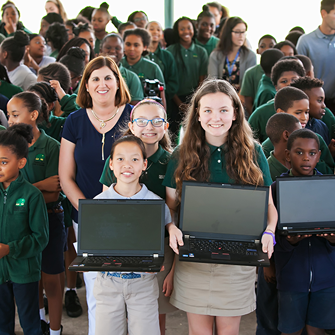
In a world where sustainability has become a central concern, the fusion of technology and ecology has given rise to a new breed of innovative businesses – eco-startups. These companies leverage cutting-edge technology to address environmental challenges and create sustainable solutions. As society embraces the need for a greener future, the rise of these eco-startups marks a fundamental shift towards a more sustainable and environmentally conscious world.
Technology has always been a catalyst for change. From the industrial revolution to the digital age, technological advancements have shaped the way we live and interact with the world. Today, technology is playing a pivotal role in the green revolution, enabling us to tackle pressing environmental issues effectively.
One notable area where technology and ecology intersect is renewable energy. With the development of more efficient solar panels and wind turbines, eco-startups are harnessing the power of clean and renewable energy sources to reduce reliance on fossil fuels. These innovative technologies not only mitigate the adverse effects of climate change but also contribute to the creation of a sustainable energy future.
Another domain where technology is making a significant impact is waste management. Eco-startups are leveraging sophisticated algorithms and data analytics to optimize waste collection, recycling, and disposal processes. By deploying smart waste management systems, these startups ensure efficient utilization of resources, minimize landfill waste, and contribute to the circular economy.
With the increasing awareness of environmental issues and the growing demand for sustainability, eco-startups are emerging as key players in the business landscape. These startups are at the forefront of innovation, developing groundbreaking solutions that address environmental challenges while providing economic opportunities.
Eco-startups focus on a wide range of sectors, including renewable energy, waste management, agriculture, transportation, and water conservation. By incorporating technology into their business models, they are able to tackle these sectors’ issues with efficiency and effectiveness.
One example of a successful eco-startup is EcoSprout, a company that specializes in vertical farming. Through the use of advanced hydroponic systems and cloud-controlled environments, EcoSprout is able to grow high-quality organic produce in urban areas using minimal water resources. Not only does this innovative approach eliminate the need for large-scale agricultural practices, but it also reduces transportation costs and carbon emissions associated with traditional farming methods.
Another notable eco-startup making waves in the green industry is EcoMotive, a company dedicated to transforming transportation through electric bike technology. By providing sustainable and eco-friendly alternatives to traditional modes of transportation, EcoMotive not only reduces carbon emissions but also promotes a healthier and greener lifestyle.
The rise of eco-startups has far-reaching implications for both the environment and the economy. By leveraging technology to find sustainable solutions, these startups are driving change and challenging traditional business models.
One major impact of eco-startups is the creation of new job opportunities. As these companies grow, they require skilled professionals in various fields, from renewable energy specialists to data analysts and engineers. This contributes to economic growth while fostering a greener and more sustainable workforce.
Furthermore, eco-startups are creating a ripple effect by inspiring larger established companies to adopt sustainable practices. As consumers become more environmentally conscious, they gravitate towards businesses that demonstrate a commitment to sustainability. By embracing eco-friendly practices, established companies can enhance their brand reputation, attract new customers, and contribute to a more sustainable future.
While the rise of eco-startups is undoubtedly promising, they still face numerous challenges that need to be addressed. Funding remains a significant obstacle, as eco-startups often struggle to secure financial support due to the perception of higher risk associated with sustainable ventures. To overcome this hurdle, governments and private investors need to provide more resources and incentives for eco-startups to thrive.
Another challenge lies in scaling sustainable technologies. While eco-startups may create innovative solutions, the ability to scale these technologies and make them accessible to a broader demographic is critical for widespread impact. Collaboration between eco-startups, research institutions, and corporate partners is essential to facilitate the scaling process and ensure that sustainable technologies reach their full potential.
The fusion of technology and ecology through the rise of eco-startups marks a significant step towards a more sustainable future. By leveraging the power of technology, these startups are addressing pressing environmental issues and offering innovative solutions. The impact of eco-startups extends beyond the creation of a more sustainable world – it fosters economic growth, inspires established businesses to adopt sustainable practices, and encourages individuals to embrace a greener lifestyle. As we continue to tackle environmental challenges, eco-startups will undoubtedly play a vital role in shaping our collective future.
Fill out the form below to request your electronics recycling pickup.
We’ll coordinate the schedule logistics and follow up with next steps.
When children have real access to devices and connectivity, learning to code stops being a luxury — it becomes a tool for personal and community growth. Studies show that in the U.S., access still varies significantly by income and education level. For example, in 2021, 93% of children ages 3 to 18 had internet access at home through a computer, but that number dropped to 78% when their parents did not complete high school.
At eSmart Recycling, we work to make sure the kids who are usually left behind also get a fair chance to connect, learn, and create.
Coding goes far beyond technical knowledge: it helps develop logic, structured thinking, collaboration, and creativity. Research shows that children exposed to coding classes demonstrate improvements in planning, problem-solving, and executive function.
It also fosters self-expression and teamwork — it’s not just about “following instructions”.
For companies and sustainability leaders, enabling access to technology doesn’t just “tick a CSR box.” It genuinely changes life trajectories.
Although it may seem like “everyone has internet,” the reality is more complex. In the U.S., children whose parents hold a college degree have a 98% rate of computer-based internet access, compared to just 78% among those whose parents did not complete high school. Another study estimated that up to 15–16 million K-12 students lacked adequate devices or connectivity during the pandemic.
These disparities limit a child’s ability to participate in coding programs or other digital learning opportunities — even when classes are available.
When a child has a working computer, stable internet, proper software, and someone to guide them, measurable benefits appear:
At eSmart Recycling, we collect electronic equipment — computers, laptops, printers, routers, cables, and more — then audit, securely destroy data, and revalue each device. Around 30% of the revenue is dedicated to repairing and donating technology to children, families, and underserved communities across the U.S. We also issue data destruction certificates and track the environmental and social results. Each device we restore helps a child gain access to the tools they need to learn coding from home or in a community space.
Ensuring fair access to technology for children is not just a sustainability initiative; it’s a concrete way to open doors to coding education and all the benefits that come with it. When a child receives a refurbished laptop, an entire world opens up. We’re here to make sure that the world reaches them.
Recycling old tech equipment isn’t as complicated—or as risky—as many people think. Whether you manage sustainability at a company or handle hardware upgrades, understanding and debunking the main myths about electronic recycling is key. Here are the most common ones and what’s actually true.
The truth: It absolutely does.
Many assume that throwing away an old computer or server doesn’t have much environmental impact. But according to the United Nations University, the world generated 62 million metric tons of e-waste in 2022, and that number could reach 82 million by 2030.
Those discarded devices also contain valuable metals like gold, silver, and copper.
At eSmart Recycling, we see it every day: every device collected, audited, and refurbished prevents toxins from entering landfills and keeps resources in use longer.
The truth: Size doesn’t matter.
People often think that TVs, printers, and large monitors are the only items worth recycling. In reality, small tech like routers, cables, laptops, and tablets also contain hazardous materials and valuable components. For companies, that means no piece of hardware should be ignored—everything has value when managed properly.
The truth: Electronic waste requires specialized handling.
E-waste contains materials like lead, mercury, and cadmium, which must be processed differently from plastic or cardboard.
Most local recycling programs aren’t equipped to destroy data or safely disassemble devices.
That’s why at eSmart Recycling, we handle the full process: collection, secure data destruction (in compliance with HIPAA), and evaluation for reuse or donation. When your company upgrades hardware, always choose a certified partner.
The truth: Simple deletion isn’t secure.
Formatting or resetting a hard drive doesn’t guarantee that data is gone for good. Experts confirm that information can often be recovered if not properly destroyed.
At eSmart Recycling, we follow strict data destruction protocols, maintain chain-of-custody tracking, and issue certificates of destruction—so companies have full proof of compliance.
The truth: It depends on the recycler.
There have been cases of illegal or irresponsible e-waste export. But standards like R2v3 and e-Stewards exist to prevent that and ensure responsible recycling.
When your company works with a certified and transparent partner, you can be confident your devices won’t end up dumped or dismantled without oversight. At eSmart Recycling, we operate under R2v3 certification and provide full traceability.
Recycling technology isn’t just a task—it’s a responsibility. Every laptop or server carries valuable materials, sensitive data, and the chance for a second life.
At eSmart Recycling, that’s what drives us: protecting the planet, securing information, and giving devices a meaningful new purpose.
Doing it right might take a bit more effort, but it always leaves a cleaner trace.
When your company retires old devices without a rigorous process, it’s placing itself at risk of data breaches, compliance penalties, and reputational damage. If you spot any of the red flags below, it’s time to reevaluate your endpoint disposal. As part of our work at eSmart Recycling, we specialise in secure data destruction, reuse, and recycling of corporate electronics — so we know what to look out for.
Improper disposal of IT assets is increasingly a source of data exposure. Research finds that organisations are leaking sensitive information because end-of-life devices are discarded without sufficient sanitisation. For example, one source shows that 30% of breaches had third-party involvement or poor disposal practices.
In practical terms, if you don’t know where your retired devices are or how their data was handled, you leave a gap that attackers can exploit.
If your company doesn’t maintain a detailed inventory of what devices are being retired, where they go, and who handles them, you may have assets “floating” unmanaged. One article emphasises that disposal should be as controlled as deployment.
What to do: Ensure all devices slated for disposal are logged, tracked, and assigned a responsible person. Update your asset register accordingly.
Simply formatting a hard drive or deleting files is not enough. Studies show that many end-of-life devices still harbor recoverable data because sanitisation was incomplete.
What to do: Use certified processes (for example, aligned to standards such as NIST SP 800‑88), require a certificate of destruction, and retain proof of data wiping or physical media destruction.
Depending on your sector, regulations such as HIPAA (healthcare) or PCI DSS (payment card industry) may apply. One article warns that failure to follow proper disposal processes can lead to legal risk.
What to do: Identify which regulations apply to your business. When you engage a disposal partner, ensure they comply and can provide documentation.
Donating or recycling equipment is often positive, but if devices haven’t been cleared of data or you don’t know the chain of custody, the risk remains. For example, one case described an institution that donated devices with student records still accessible.
What to do: Whether you donate, reuse, or recycle, each device should pass through your secure disposal pipeline: auditing, data removal, certified destruction (or reuse), and tracking of final destination.
If your company doesn’t require and retain disposal reports, certificates of destruction, or details on where each device ended up, you lack evidence that the process was done correctly. As a result, if a breach happens, you may be unable to show due diligence.
What to do: Insist on disposal partners delivering: (a) certificate of data destruction; (b) statement of equipment final destination (reused/resold/recycled); (c) metrics if applicable (e.g., number of devices reused, environmental benefit).
Retiring equipment without a secure process isn’t simply “clearing shelves” — it’s a vulnerability waiting to be exploited. At eSmart Recycling, we handle this every day: secure data wiping, verified reuse where possible, and proper recycling where needed. If you recognise any of these signs in your organisation, act now. Your data, your customers, and your reputation will be safer for it.
Access to technology is no longer optional — it’s essential. It defines how companies operate, how people connect, and how communities grow. For businesses that care about sustainability and social responsibility (like us at eSmart Recycling), understanding digital inclusion is key to creating long-term value.
Digital inclusion means ensuring that people and communities have access to the right devices, reliable internet, the necessary skills to use them, and opportunities to engage with meaningful digital content. According to the Internet Society, the digital divide is no longer just about infrastructure — it’s about how technology is used and who can truly benefit from it.
In the U.S., around 18 million households either rely solely on a smartphone or lack a personal computer altogether. That means millions are still unable to participate in education, work, or civic life fully.
Most jobs today require at least some level of digital skill. The National Skills Coalition found that 48 million U.S. workers lack basic digital skills. When employees or suppliers fall behind digitally, productivity and innovation suffer.
Supporting digital inclusion — through donations, training, or access to refurbished devices — strengthens both brand reputation and community well-being. At eSmart Recycling, we collect and audit electronics, securely destroy data, and recondition devices to give them a new life in the hands of families and schools that need them.
Digital inclusion also supports circular economy goals. Extending the life of electronic devices reduces e-waste and carbon emissions. Each reused laptop or desktop means fewer resources mined, manufactured, and discarded.
Digital inclusion isn’t a side project — it’s part of building sustainable, connected communities. Companies can start by collecting their unused devices, partnering with certified recyclers, and helping close the access gap.
At eSmart Recycling, we already do this every day: we collect, audit, refurbish, donate, and certify data destruction. That’s how technology finds a new purpose — and how inclusion grows.
Tech companies can change the way they design products by applying the principles of circular design: reducing waste, keeping materials in use for longer, and regenerating natural systems. These three ideas help companies like ours, eSmart Recycling, extend the life of electronic devices while supporting vulnerable communities.
Circular design means creating products that are durable, repairable, reusable, and recyclable—considering every stage of the product’s life cycle: raw materials, manufacturing, use, and end-of-life.
For tech companies that make or handle devices like laptops, routers, or cables, this approach helps cut down e-waste and recover value. The U.S. Environmental Protection Agency (EPA) defines a circular economy as one that keeps products and materials in circulation for as long as possible and eliminates the idea of “waste” through smarter design.
When designing electronics, key questions include: can the device be easily disassembled? Does it contain toxic materials that make recycling harder? The Ellen MacArthur Foundation highlights eliminating waste and pollution from the design stage as a core pillar of circularity.
In practice, this might mean using recycled plastics, reducing complex fastenings, documenting disassembly processes, and setting up take-back programs for obsolete equipment.
This principle encourages design for reuse, repair, upgrade, and recycling.
Examples include laptops that let users replace batteries or drives, or routers with casings that can be reused with new boards. Some companies are also adopting “as-a-service” business models, where the manufacturer collects, refurbishes, and redeploys products to keep materials circulating.
Dell Technologies, in its circular economy roadmap, emphasizes designing for repairability, reusability, and recyclability as key steps toward its net-zero goals.
This idea goes beyond preventing harm—it’s about restoring value to ecosystems.
For technology, this could mean feeding recovered materials back into production cycles, using renewable energy in manufacturing or refurbishing processes, and reducing the footprint of resource extraction.
Adopting circular design isn’t just about environmental responsibility—it’s also good business. Reducing waste, extending product life, and returning materials to circulation help strengthen community programs like ours at eSmart Recycling while improving long-term sustainability.
The question is straightforward: what happens when several organizations coordinate to give veterans access to technology and digital training? This recent deployment offered a clear answer. A group of 47 veterans in the Operation: Veteran Connect program received refurbished laptops to stay connected to their routines, families, and educational resources.
Many veterans still face barriers that limit their ability to use technology. A report from the Federal Communications Commission (FCC) noted that 2.2 million veteran households lack fixed broadband, mobile broadband, or both, and that veterans are more likely than non-veterans to cite the absence of a computer or an adequate device as a key reason for not adopting digital services. The report also mentions that many veterans live in rural areas and that older veterans often have fewer digital skills.
This deployment aimed to provide a reliable device ready for use, along with training sessions facilitated by Community Tech House. The goal was to help participants handle everyday tasks, take online courses, or communicate more easily.
At eSmart Recycling, we handled equipment collection, secure data destruction, and device preparation. Our corporate partners — AVISPL and the University of South Florida (USF) — donated the equipment they no longer needed. We then took care of the audit process, secure data wiping, and refurbishment.
After that step, the Digital Education Foundation, together with Seniors in Service and Community Tech House, delivered the laptops and guided the veterans through digital lessons tailored to their needs.
The day of the deployment had a relaxed, friendly tone. Some veterans took their time exploring the keys; others mentioned they hadn’t had a personal device in years, and several talked about wanting to reconnect with family members or continue online learning opportunities.
The recipients were 47 veterans from the Operation: Veteran Connect program. They came with different backgrounds, ages, and reasons for wanting a laptop: staying in touch with loved ones, improving digital skills, managing VA-related tasks, or simply having a device they could depend on.
This result was possible thanks to coordinated work across community groups, companies that recycle their equipment with us, and organizations dedicated to digital education.
Deployments like this one will continue as long as there is collaboration between Seniors in Service, Digital Education Foundation, Community Tech House, our corporate partners, and our team at eSmart Recycling. Each program allows more veterans to use technology they previously did not have access to.
We invite companies interested in recycling their equipment to work with eSmart Recycling. Your participation helps us prepare more laptops and support more people in future deployments.







If you want to know more about the different programs, partners, and overall cool things happening in the eSmart world, share your email with us, and Join the E-Revolution.